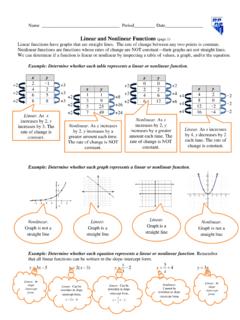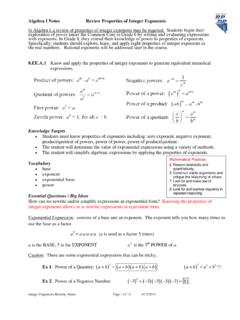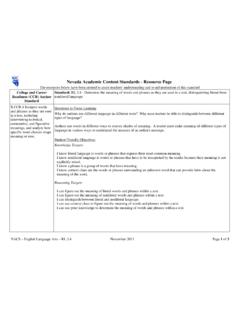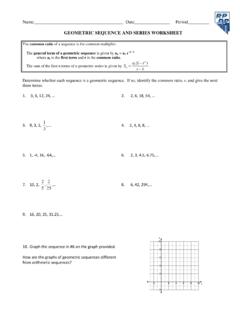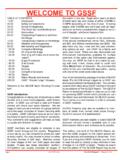Transcription of Common Core State Standards - RPDP
1 Common core State Standards ELA 9-10: Writing Strand Page | 1. Focus: Convince Me !: An Introduction to Argumentative Writing Common core Writing Standard 1. Overview This lesson is intended to introduce students to the art of argumentative writing by familiarizing them with basic terms; allowing students to practice establishing the relationship between claims, reasons, and evidence; and analyzing an author's use of argument in a text. Standards Write arguments to support claims in an analysis of substantive topics or texts, using valid reasoning and relevant and sufficient evidence. a. Introduce precise claim(s), distinguish the claim(s) from alternate or opposing claim(s). and create an organization that establishes clear relationship among claim(s), counterclaims, reasons, and evidence. b. Develop claim(s) and counterclaims fairly, supplying evidence for each while pointing out the strengths and limitations of both in a manner that anticipates the audience's knowledge level and concerns.
2 C. Use words, phrases, and clauses to link the major sections of the text, create cohesion, and clarify the relationships between claim(s) and reasons, between reasons and evidence, and between claim(s) and counterclaims. d. Establish and maintain a formal style and objective tone while attending to the norms and conventions of the discipline in which they are writing. e. Provide a concluding statement or section that follows from and supports the argument presented. Objectives Differentiate between persuasion and argument Introduce (or review) language of argumentation To recognize argumentative techniques in a variety of text To formulate an argument with a claim and counter-claim To reach a logical conclusion Southern Nevada Regional Professional Development Program 515 West Cheyenne, Suite C (702) 799-3828. North Las Vegas, NV 89030 FAX (702) 799-3821. Common core State Standards ELA 9-10: Writing Strand Page | 2.
3 Materials Access to the Internet for the Interactive Persuasion Map exercise Access to the Internet for this helpful information on organizing claims and counter- claims Activity 1: What is an Argument? Discussion Solicit students' answers to the question, What is an argument? Put answers on board. Answers may range from a fight to trying to get someone to believe your point of view or other possibilities. For the purposes of English, an argument is defined as follows: An argument is a reasoned, logical way of demonstrating that the writer's position, belief, or conclusion is valid. In English, students make claims about the worth or meaning of a literary works, defending their interpretation with evidence from the text, for example. In short, arguments seek to make people believe that something is true or to persuade people to change their beliefs or behavior. What is the difference between argument and persuasion?
4 An argumentative essay A persuasive essay Makes claims based on factual May make claims based on evidence opinion Makes counter-claims. The May not take opposing ideas into author takes opposing views account into account. Neutralizes or defeat serious opposing ideas Convinces audience through Persuades by appealing to the the merit and reasonableness audience's emotion or by relying of the claims and proofs on the character or credentials of offered the writer less on the merits of Southern Nevada Regional Professional Development Program 515 West Cheyenne, Suite C (702) 799-3828. North Las Vegas, NV 89030 FAX (702) 799-3821. Common core State Standards ELA 9-10: Writing Strand Page | 3. her or his reasons and evidence. Often compares texts or ideas to establish a position Logic-based Emotion-based Lecture, Continued Define important terms for argumentation below. Ask students to generate independent examples of all of the following and put them on the board for discussion and reflection.
5 Key Terms for Argumentation Claim Your basic belief about a particular topic, issue, event, or idea Counterclaim A solid and reasonable argument that opposes or disagrees with your claim Rebuttal A written or verbal response to a counterclaim. The object of the rebuttal is to take into account the ideas presented in the counterclaim and explain why they aren't persuasive enough, valid enough, or important enough to outweigh your own claim. Support Your specific facts or specific evidence used to support why your claim is true Refute Argue against a position or prove it to be wrong Qualify A partly-agree stance in which you agree (in part) with another person's argument or position but also disagree with part of it. If students are reluctant to participate, ask someone to make a claim regarding the dumbest video on Youtube (or some other student-friendly topic). Have others make counterclaims, rebuttals, offer support, refutation, qualification, et cetera.
6 As discussion continues, teachers may need to clarify understanding and emphasize the need for evidence that is, specific facts, not hypothetical situations ( , Let's say you have a guy who ), not opinions, not generalities ( , Well, people always ). Without solid evidence, an argument lacks merit. Southern Nevada Regional Professional Development Program 515 West Cheyenne, Suite C (702) 799-3828. North Las Vegas, NV 89030 FAX (702) 799-3821. Common core State Standards ELA 9-10: Writing Strand Page | 4. Teachers may also need to emphasize an idea many students may resist: that their argument is made stronger by introducing a good, solid counterclaim. (Note: Some students will think this idea is whackadoo why, they'll reason, should you put words in the mouth of your opponent?). Teachers will need to demonstrate the value of the preemptive strike, the virtue of framing the other person's argument to one's own advantage.
7 Conclusion Review crucial terms and discuss the progression of the unit from this point, giving a preview of the use of argument in the classroom. Rapid question-and-answer in a class Jeopardy format to review key terms might also conclude the class. Activity 2: Playing With Arguments Discussion Review key terms or ideas ( , claim, counterclaim, argument vs. persuasion, etc.) before proceeding. Persuasion Map For this activity, students will need independent use of computers and access to the Internet. In order to play around with (and reinforce) the idea that argumentation needs to be based on facts, students will play with the Interactive Persuasion Map on the linked site. Students should be encouraged to have fun with the site. The purpose (as of now) is to familiarize students with the logical process of thought involved in creating an argument. Students may generate deliberately silly topics to defend ( , Boxing dinosaurs is far superior to all other summertime sports ) or choose more serious ones if they choose.
8 Conclusion Have students print their Persuasion Maps on the website for future reference. The graphic on the site is helpful as a way of visualizing the relationship between the thesis, the evidence, and the explanations. Later Use As students develop (more serious) argumentative essays later, the Interactive Persuasion Map site may be a very helpful tool to aid students in outlining or brainstorming. Southern Nevada Regional Professional Development Program 515 West Cheyenne, Suite C (702) 799-3828. North Las Vegas, NV 89030 FAX (702) 799-3821. Common core State Standards ELA 9-10: Writing Strand Page | 5. Activity 3: Analyzing Arguments Opener Teachers will choose an appropriate speech from the resources below to read aloud. Note: Provide students with copies of their own to follow along with during the reading. Teachers may choose to read examples or short selections from several speeches instead of just one, making sure that each selection presents sufficient information for students to discover in the group-work activity below ( , the selection should contain a claim, reasons, facts, et cetera).
9 Small Groups Following the reading, students can separate into small groups to discover the following information: 1. What is the speaker's claim? What does s/he want you to believe? 2. What reasons does s/he give for his claim? 3. What facts, quotations, evidence, or specific details does s/he give to support those reasons? 4. Is there a counterclaim? What is it? Whole-Group Discussion Following the group-work, the entire class can reconvene. Some groups will disagree about the claims and counterclaims, et cetera. The teacher's focus should be to get students to use specific evidence from the text to support their points, , Okay, Billy, what do you think Patrick Henry is arguing? Can you point out the part of the speech that made you come to the conclusion you did? Can you read it for us, please? . Great Speeches Patrick Henry Speech to the Second Virginia Convention . Thomas Jefferson Declaration of Independence.
10 ~dee/ Edgar Allan Poe Sonnet to Science . Theodore Roosevelt The Proper Place for Sports . Southern Nevada Regional Professional Development Program 515 West Cheyenne, Suite C (702) 799-3828. North Las Vegas, NV 89030 FAX (702) 799-3821. Common core State Standards ELA 9-10: Writing Strand Page | 6. a2-16-10. Billy Collins The History Teacher . Martin Luther King, Jr. Address at the March on Washington . August 28, 1963 . Nelson Mandela Inauguration Speech 1994 . :8080/~wldciv/world_civ_reader/world_ci v_reader_2 Invictus DVD (clip only). Franklin Delano Roosevelt State of the Union January 1944 . t=463. (Note: Many of these speeches are from the Common core list;. all are readily available on-line. Also, many can be accessed (and listened to) on the American Rhetoric web site explore it!). Conclusion Draw students' attention to the fact that we use argument throughout our lives. Learning to assemble arguments, fairly deal with opposing ideas, and support those ideas with facts is crucial.




